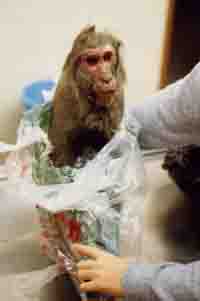Top | CV | Publications | Study | Gallery
Other studies
These are studies when I was an undergraduate or master student.
1. Conservation ecology of Japanese macaques in Hieizan
 I studied Japanese macaques in Mt. Hieizan, in the suburbs of Kyoto, as my
graduate study. There is a very famous temple of 1200 years old here, and
monkeys there are non-systematically provisioned by the tourists who visit the
temple. Monkeys also raid crops in the foot of the mountain. I clarified that
these artificial food enhanced the reproduction of this population.
I studied Japanese macaques in Mt. Hieizan, in the suburbs of Kyoto, as my
graduate study. There is a very famous temple of 1200 years old here, and
monkeys there are non-systematically provisioned by the tourists who visit the
temple. Monkeys also raid crops in the foot of the mountain. I clarified that
these artificial food enhanced the reproduction of this population.
During the observation of this population, I observed an expeditionary ranging
by a macaque troop. This was surprising, considering the philopatric nature of
macaque troops. Read the abstract
Fieldwork was conducted from April to November 1996.
This is a Japanese newspaper, telling that a Japanese
macaque troop suddenly appeared in the tomb of an emperor. I am the man in the
right of the photo. Regrettably, I have not seen the macaques in Hieizan since I
started studying in Yakushima, although I saw the mountain from the window of my
laboratory in Kyoto everyday! I think it was a good opportunity for me to work
not only with completely wild monkeys like the ones in Yakushima, but also with
these 'urbanized' monkeys.
2. Studies on Japanese macaques in the western lowland forest of Yakushima

My master's thesis was on the age difference in the food intake and dietary
composition of Japanese macaques in the western coastal forest of Yakushima.
During the observation in this area, mass mortality of Japanese macaques
occurred. Mortality of 115 monkeys belonging to the five intensively studied
groups between 1998-1999 reached 61%. This finding revealed that primate
populations fluctuate over the long term in a seemingly stable habitat
without any artificial disturbance.
Read the abstract of the paper on age difference in diet
Read the abstract of the paper on mass mortality
Western lowland forest of Yakushima is the long-term study site for Japanese
macaques. It was a good place to practice various research skills for young
primatologists, like me at that time. However, it was quite difficult to
find topics which had not been studied by others.
This is the dead alpha-male of my study troop. According to the necropsy, the cause was diagnosed as pneumonia. His death was the beginning of the mass mortality, but I did not realize until finishing the thesis and going back to Yakushima. My study troop had completely died off at that time. I had hard days when I could not see any of my monkeys in the forest but found only skeletal carcasses day after day.
.
Go back to the top page
<Written by: Goro Hanya
(hanya.goro.5z<atmark>kyoto-u.ac.jp)>
<Contact: Goro Hanya
(hanya.goro.5z<atmark>kyoto-u.ac.jp)>
<Last update: December 24, 2010>
 I studied Japanese macaques in Mt. Hieizan, in the suburbs of Kyoto, as my
graduate study. There is a very famous temple of 1200 years old here, and
monkeys there are non-systematically provisioned by the tourists who visit the
temple. Monkeys also raid crops in the foot of the mountain. I clarified that
these artificial food enhanced the reproduction of this population.
I studied Japanese macaques in Mt. Hieizan, in the suburbs of Kyoto, as my
graduate study. There is a very famous temple of 1200 years old here, and
monkeys there are non-systematically provisioned by the tourists who visit the
temple. Monkeys also raid crops in the foot of the mountain. I clarified that
these artificial food enhanced the reproduction of this population. 